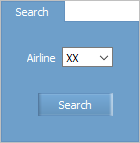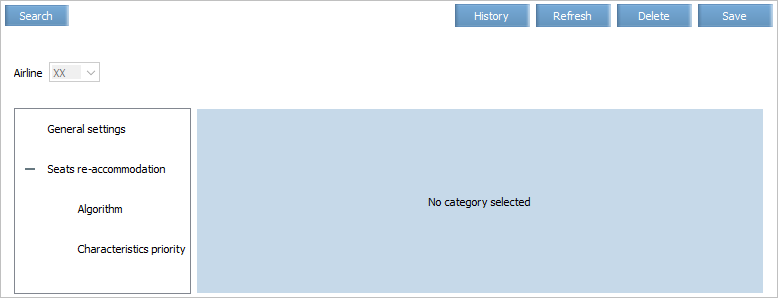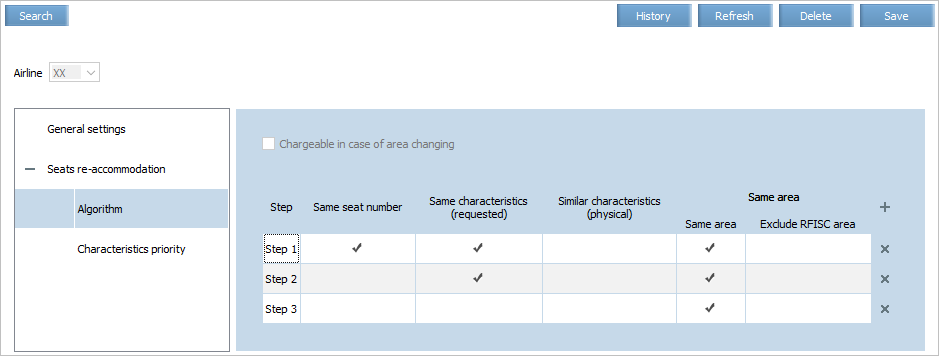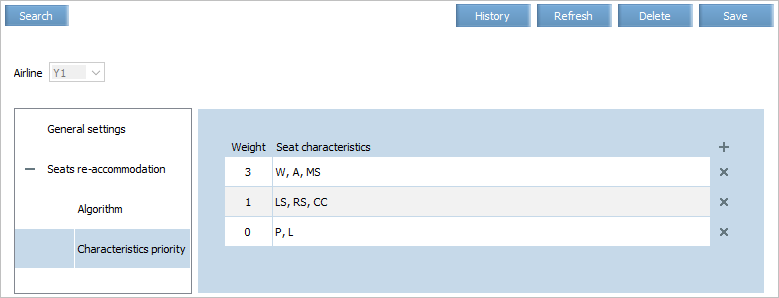Re-accommodation Settings
The parameters of re-accomodation settings are presented in the Re-accommodation → Settings section for the selected airline.
There are the following setting categories:
- General settings
- Seats re-accomodation
- Algorithm
- Characteristics priority
General Settings
The General settings are the following:
The parameters have the following description and value format:
| Parameter | Description | Format |
|---|---|---|
| System search range | Number of days before and after a specified date of a flight departure within which an automatic search of an alternate flight is carried out if it is required to carry out re-accommodation | Number from 0 to 3. It is specified separately for the every period:
The settings for these periods may be different |
| Rebook “waitlisted” PNR’s | Re-accommodation of waitlisted PNRs allowance |
|
| Rebook PNR’s “on request” | Re-accommodation of “on request” PNRs allowance |
|
| Rebook “SA” PNRs | Re-accomodation of PNRs with SA segments allowance, it is not set by default | For the automatic re-accomodation plan:
For the manual re-accomodation plan:
|
| Ignore bad connection | Re-accommodation with bad connection allowance |
|
The business rules that manage the re-accomodation's general settings are presented in the table below.
| Setting | Business rule name | Business rule group |
|---|---|---|
| System search range | Search flight range | Management of re-accommodation |
Click Save after the parameters are changed.
Seats Re-accomodation
The seats re-accomodation process allows a carrier the following setup according to own purposes and tasks:
- selection steps for seats during the re-accomodation
- priority of seat characteristics.
To setup steps (stages) of seat selection, open the Re-accomodation → Settings → Seats re-accomodation → Algorithm.
The settings of this section replace the «Seat Re-allocation» business rule.
If the «Seat Re-allocation» business rule was not set, then the «Algorithm» settings consist of only 3 steps by default. Else, another 2 steps with parameters according to the business rule will be added.
The seats re-accomodation algorithm has the following parameters:
- Same seat number – available seat with the same number in the requested class
- Same characteristics (requested) – seat characteristics that are clearly requested by booking
- Same characteristics (physical) – if the parameter is set, then it works as the following filter: seats that have no net characsteristics with the original seat are excluded, the remaining seats are sorted by characteristic weight that based on the data from the Characteristics priority category
- Same area – the seat area is always saved (RFISC, Free space, SSP, Mkt_BS)
- Exclude RFISC area – the re-accomodation in RFISC area from the unavailable original area is not allowed.
The combined work of the Same area and Exclude RFISC area parameters is the following:
| Same area | Exclude RFISC area | Net setting result |
|---|---|---|
| The following re-accomodation is allowed: on original area seats, on seats without area or with any RFISC area | ||
| ✔ | The following re-accomodation is allowed: on original area seats or on seats without area | |
| ✔ | The re-accomodation is allowed on original area seats only | |
| ✔ | ✔ | Invalid setting |
The Chargeable in case of area changing parameter becomes active when the algorithm has at least one step without both the Same area and Exclude RFISC area parameters. The flag applies only for the situation when a passenger is re-accomodated from a free (non-chargeable) seat to a seat in RFISC area. If the flag is selected, then the payment for seat changing will be requested (RFISC with the HD status will be added to the order) or the paid seat is assigned without charge (RFISC with the HK status will be added to the order).
When the System initiates the seat re-accomodation process, the seat search begins using the algorithm's first step settings. The first step provides the saving of the original seat number and its area. If the seat number is somehow unavailable or it is available but belongs to other area, then it is assumed that nothing was found during the first step and the second step begins.
This step provides the search of seats that belong to the original area and have the requested characteristic as the original one (for the case when the seat booking was performed with the request of the certain characteristic such as 3C1P1SEATW.
If several seats are found, then the System sorts them using the logic of sequential seat match. Its algorithm consists of the following steps:
- Selection of space by its weight (descending value).
- Selection by seat preferred characteristic weight (descending value). New seat characteristics are accounted by the weight table (Characteristics priority). The following weights are compared: for the initial seat and for the new one.
- Selection by the seat preferred characteristics that are not present for the initial seat (ascending weight value) using only the list from the Characteristics priority table.
- Selection by distance of raws/seats (ascending value). For the seats of the same raw, if there is a seat with the same number, then this seat will be selected. If raws of possible new seats are equidistant from the initial one, then the raw closer to aircraft head is selected.
- Selection by RFISC space affilation – seats without RFISC will be selected first.
If all steps are passed but acceptable seat was not found, then the System leaves the seat on request (the HN status).
The Same characteristics parameter works with the data from the Characteristics priority category: Re-accomodation → Settings → Seats re-accomodation → Characteristics priority.
The weight values are used to estimate the seat selection priority. Seat characteristics that are not included in the settings have the weight = 0.
The characteristics of the original seat are compared by weight with the ones of the found seat. The found seats are sorted by their characteristic weight. If the weights are equal, then the priority is assigned to the seat with characteristics that are most similar to the ones of the original seat according to the seat row (the minimum distance of the found seat from the original one's row).
If the Same characteristics parameter is selected, then seats that have none of the priority characteristics are excluded. Else, all seats are estimated in the algorithm's late steps.
See also:
- Forming a Re-accommodation Task
- Forming a Re-accommodation Plan
- Forming a Re-accommodation Solution
- Viewing Re-accommodation Tasks and Reports
- Business Rules for Re-accommodation Management
- Additional Options




